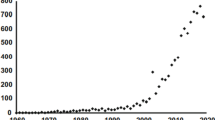Abstract
We present a minimal two-component model that can exhibit various types of spatial patterns including patchiness. The model, comprising nutrients and phytoplankton, includes the effect of nutrient uptake by phytoplankton as a Holling type II functional response, and also includes the effect of zooplankton grazing on phytoplankton as a Holling type II non-dynamical term. The mean-field model without the diffusion and advection terms shows both bistability and limit-cycle oscillations as a few parameters such as the input rate of nutrients and the maximum feeding rate of zooplankton are changed. If the parameter values are chosen from the limit-cycle oscillation region, the corresponding reaction-advection-diffusion equations show spatial pattern formations by the combined effects of advection and diffusion by turbulent stirring and mixing, and biological interactions. As the nutrient input is increased, the system behaviour changes from the extinction of the entire phytoplankton to the formation of filamentous patterns, patchiness patterns and homogeneous distributions. These observations suggest that the spatial pattern of phytoplankton can function as an indicator to evaluate the eutrophication level in aquatic ecosystems.
Similar content being viewed by others
References
Abraham E R 1998 The generation of plankton patchiness by turbulent stirring; Nature (London) 391 577–580
Amemiya T, Enomoto T, Rossberg A G, Takamura N and Itoh K 2005 Lake restoration in terms of ecological resilience: a numerical study of biomanipulations under bistable conditions; Ecol. Soc. 10 3
Bohannan B J M and Lenski R E 1997 Effect of resource enrichment on a chemostat community of bacteria and bacteriophage; Ecology 78 2303–2315
Bowie G L, Mills W B, Porcella D B, Campbell C L, Pagenkopf J R, Rupp G L, Johnson K M, Chan P W H and Gherini S A 1985 Rates, constants, and kinetics formulations in surface water quality modeling 2nd edition (Athens: US Environmental Protection Agency)
DeAngelis D L, Bartell S M and Brenkert A L 1989 Effects of nutrient recycling and food-chain length on resilience; Am. Nat. 134 778–805
Dyke P P G and Robertson T 1985 The simulation of offshore turbulent dispersion using seeded eddies; Appl. Math. Model. 9 429–433
Gentleman W, Leising A, Frost B, Strom S and Murray J 2003 Functional responses for zooplankton feeding on multiple resources: a review of assumptions and biological dynamics; Deep-Sea Res. II 50 2847–2875
Holling C S 1973 Resilience and stability of ecological systems; Annu. Rev. Ecol. Syst. 4 1–23
Luckinbill L S 1974 The effects of space and enrichment on a predator-prey system; Ecology 55 1142–1147
McCauley E and Murdoch W W 1990 Predator-prey dynamics in environments rich and poor in nutrients; Nature (London) 343 455–457
Martin A P 2003 Phytoplankton patchiness: the role of lateral stirring and mixing; Prog. Oceanogr. 57 125–174
Medvinsky A B, Petrovskii S V, Tikhonov D A, Tikhonova I A, Ivanitsky G R, Venturino E and Malchow H 2001 Biological factors underlying regularity and chaos in aquatic ecosystems: simple models of complex dynamics; J. Biosci. 26 77–108
Medvinsky A B, Petrovskii S V, Tikhonova I A, Malchow H and Li B-L 2002 Spatiotemporal complexity of plankton and fish dynamics; SIAM Rev. 44 311–370
Mullin M M, Stewart E F and Fuglister FJ 1975 Ingestion by planktonic grazers as a function of food concentration; Limnol. Oceanogr. 20 259–262
Neufeld Z, Haynes P H, Garçn V and Sudre J 2002 Ocean fertilization experiments may initiate a large scale phytoplankton bloom; Geophys. Res. Lett. 29 10.1029/2001GL013677
Okubo A 1971 Oceanic diffusion diagram; Deep-Sea Res. 18 789–802
Petrovskii S V and Malchow H 1999 A minimal model of pattern formation in a prey-predator sysyem; Math. Comput. Model. 29 49–63
Petrovskii S V, Li B-L and Malchow H 2004 Transition to spatiotemporal chaos can resolve the paradox of enrichment; Ecol. Complex. 1 37–47
Rietkerk M, Boerlijst M C, van Langevelde F, HilleRisLambers R, van de Koppel J, Kumar L, Prins H H T and de Roos A M 2002 Self-organization of vegetation in arid ecosystems; Am. Nat. 160 524–530
Rietkerk M, Dekker S C, de Ruiter P C and van de Koppel J 2004 Self-organized patchiness and catastrophic shifts in ecosystems; Science 305 1926–1929
Rosenzweig M L 1971 Paradox of enrichment: destabilization of exploitation ecosystem in ecological time; Science 171 385–387
Roy S and Chattopadhyay J 2007 The stability of ecosystems: a brief overview of the paradox of enrichment; J. Biosci. 32 421–428
Scheffer M 1991 Fish and nutrients interplay determines algal biomass: a minimal model; Oikos 62 271–282
Scheffer M 1998 Ecology of shallow lakes (Dordrecht: Kluwer Academic Publishers)
Sigee D C 2005 Freshwater microbiology (West Sussex: Jhon Wiley)
Turing A M 1952 On the chemical basis of morphogenesis; Philos. Trans. R. Soc. Ser. B 237 37–72
Tzella A and Haynes P H 2007 Small-scale spatial structure in plankton distributions; Biogeosciences 4 173–179
von Hardenberg J, Meron E, Shachak M and Zarmi Y 2001 Diversity of vegetation patterns and desertification; Phys. Rev. Lett. 87 198101
Vos M, Kooi B W, DeAngwlis D L and Mooij W M 2004 Inducible defences and the paradox of enrichment; Oikos 105 471–480
Author information
Authors and Affiliations
Corresponding author
Rights and permissions
About this article
Cite this article
Serizawa, H., Amemiya, T. & Itoh, K. Patchiness in a minimal nutrient — phytoplankton model. J Biosci 33, 391–403 (2008). https://doi.org/10.1007/s12038-008-0059-y
Received:
Accepted:
Published:
Issue Date:
DOI: https://doi.org/10.1007/s12038-008-0059-y




